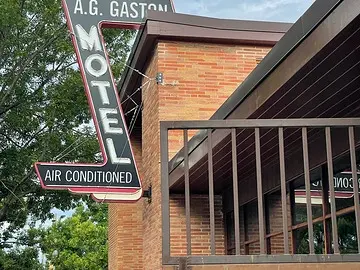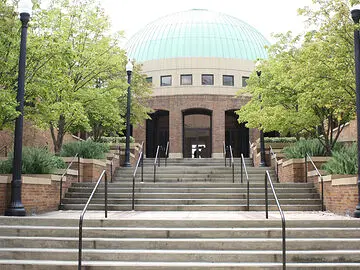Guide
8 Sites Connected With the Birmingham Civil Rights National Monument
On January 12, 2017, President Obama announced the creation of Birmingham Civil Rights National Monument in Alabama. The monument, which honors the activists who struggled for social justice throughout the Civil Rights era, aims to inspire hope and tolerance in generations of Americans to come.
The designation recognizes the city’s pivotal role in the larger Civil Rights movement and will help visitors grasp the significance of what took place here. Explore eight sites connected with the Birmingham Civil Rights National Monument.
-

Photo By: City of Birmingham
A.G. Gaston Motel
Amid the streamlined couches and carpeted floor of Room 30, or the “War Room,” civil rights luminaries like the Rev. Fred Shuttlesworth and Dr. Martin Luther King, Jr. organized protests and devised strategy for the Civil Rights movement in the early 1960s.
Learn More
-

Photo By: Cate S/Flickr/CC BY NC ND 2.0
Birmingham Civil Rights Institute
Since 1992, the Birmingham Civil Rights Institute has explored civil rights issues. A cultural and educational research center, the institute also focuses on social justice issues and efforts beyond the American Civil Rights movement of the 20th century.
Learn More
-

Photo By: Mark Sandlin
16th Street Baptist Church
On September 15, 1963, a bomber targeted Birmingham’s 16th Street Baptist Church, killing Addie Mae Collins, Carole Robertson, Cynthia Wesley, and Denise McNair—young girls who were attending Sunday school. Occurring less than a month after King delivered his "I Have a Dream" speech, the attack marked the zenith of racial violence in Birmingham during the Civil Rights movement.
Learn More
-

Photo By: Social_Stratification/Flickr/CC BY ND 2.0
Kelly Ingram Park
In May 1963, following weeks of protests, boycotts, and arrests, many of Birmingham's African American schoolchildren gathered on the lawn of the park to protest segregation. From May 2-10, 1,000 child protesters were arrested, and in the days that followed, fire-hoses and police dog tactics were used against the protesters. Today, Its famous sculptures include depictions of Martin Luther King Jr., the four girls killed in the 16th Street Baptist Church bombing, and police dogs used to attack protestors.
-

Photo By: Dystopos/Flickr/CC BY-NC-2.0
St. Paul United Methodist Church
Founded by newly freed slaves in 1869, St. Paul United Methodist Church was at the forefront of the effort to integrate those who had been released from bondage into free American society following the Civil War. On the same block as 16th Street Baptist Church, St. Paul UMC provided a meeting place for bus integration activities in the 1950s and a site for trainings in nonviolent civil disobedience during the 1960s.
Learn More
-

Photo By: Library of Congress, HABS ALA,37-BIRM,6--1
Colored Masonic Temple
Designed by Black architects Robert Robinson Taylor and Louis H. Persley, and completed in 1922, the Colored Masonic Temple in downtown Birmingham is significant as a state-of-the-art community facility designed, constructed, and financed by people of color during the time of segregation. Also known as the Masonic Temple Building, the building is slated for rehabilitation as a mixed-use project.
Learn More
-

Photo By: Jimmy Emerson DVM/Flickr?CC BY-NC-ND-2.0
4th Avenue Business District
During the Jim Crow era, this area was a hub for the city’s Black residents, housing medical and law offices, banks, and insurance companies. Today the district participates in the National Trust’s Main Street America program.
-

Photo By: Library of Congress, HABS ALA,37-BIRM,26--1
Bethel Baptist Church
Though Bethel Baptist Church is located almost two miles from the geographic center of the monument, the church served as a central meeting place for many protesting segregation in Birmingham. This church is where civil rights leader Rev. Shuttlesworth became the pastor at Bethel Baptist Church in 1953, and would later founded the Alabama Christian Movement for Human Rights.
Learn More
The effort to designate Birmingham Civil Rights National Monument, which was led by the National Trust and included a historic structures report for the A.G. Gaston Motel and other preservation expertise, would not have been possible without the help of our partners, including the city of Birmingham and its mayor William Bell, the National Parks Conservation Association, and U.S. Rep. Terri Sewell.
8 Sites Connected With the Birmingham Civil Rights National Monument
-
1


A.G. Gaston Motel
Amid the streamlined couches and carpeted floor of Room 30, or the “War Room,” civil rights luminaries like the Rev. Fred Shuttlesworth and Dr. Martin Luther King, Jr. organized protests and devised strategy for the Civil Rights movement in the early 1960s. -
2


Birmingham Civil Rights Institute
Since 1992, the Birmingham Civil Rights Institute has explored civil rights issues. A cultural and educational research center, the institute also focuses on social justice issues and efforts beyond the American Civil Rights movement of the 20th century. -
3


16th Street Baptist Church
On September 15, 1963, a bomber targeted Birmingham’s 16th Street Baptist Church, killing Addie Mae Collins, Carole Robertson, Cynthia Wesley, and Denise McNair—young girls who were attending Sunday school. Occurring less than a month after King delivered his "I Have a Dream" speech, the attack marked the zenith of racial violence in Birmingham during the Civil Rights movement. -
4


Kelly Ingram Park
In May 1963, following weeks of protests, boycotts, and arrests, many of Birmingham's African American schoolchildren gathered on the lawn of the park to protest segregation. From May 2-10, 1,000 child protesters were arrested, and in the days that followed, fire-hoses and police dog tactics were used against the protesters. Today, Its famous sculptures include depictions of Martin Luther King Jr., the four girls killed in the 16th Street Baptist Church bombing, and police dogs used to attack protestors. -
5


St. Paul United Methodist Church
Founded by newly freed slaves in 1869, St. Paul United Methodist Church was at the forefront of the effort to integrate those who had been released from bondage into free American society following the Civil War. On the same block as 16th Street Baptist Church, St. Paul UMC provided a meeting place for bus integration activities in the 1950s and a site for trainings in nonviolent civil disobedience during the 1960s. -
6


Colored Masonic Temple
Designed by Black architects Robert Robinson Taylor and Louis H. Persley, and completed in 1922, the Colored Masonic Temple in downtown Birmingham is significant as a state-of-the-art community facility designed, constructed, and financed by people of color during the time of segregation. Also known as the Masonic Temple Building, the building is slated for rehabilitation as a mixed-use project. -
7


4th Avenue Business District
During the Jim Crow era, this area was a hub for the city’s Black residents, housing medical and law offices, banks, and insurance companies. Today the district participates in the National Trust’s Main Street America program. -
8


Bethel Baptist Church
Though Bethel Baptist Church is located almost two miles from the geographic center of the monument, the church served as a central meeting place for many protesting segregation in Birmingham. This church is where civil rights leader Rev. Shuttlesworth became the pastor at Bethel Baptist Church in 1953, and would later founded the Alabama Christian Movement for Human Rights.
-
1


A.G. Gaston Motel
Amid the streamlined couches and carpeted floor of Room 30, or the “War Room,” civil rights luminaries like the Rev. Fred Shuttlesworth and Dr. Martin Luther King, Jr. organized protests and devised strategy for the Civil Rights movement in the early 1960s. -
2


Birmingham Civil Rights Institute
Since 1992, the Birmingham Civil Rights Institute has explored civil rights issues. A cultural and educational research center, the institute also focuses on social justice issues and efforts beyond the American Civil Rights movement of the 20th century. -
3


16th Street Baptist Church
On September 15, 1963, a bomber targeted Birmingham’s 16th Street Baptist Church, killing Addie Mae Collins, Carole Robertson, Cynthia Wesley, and Denise McNair—young girls who were attending Sunday school. Occurring less than a month after King delivered his "I Have a Dream" speech, the attack marked the zenith of racial violence in Birmingham during the Civil Rights movement. -
4


Kelly Ingram Park
In May 1963, following weeks of protests, boycotts, and arrests, many of Birmingham's African American schoolchildren gathered on the lawn of the park to protest segregation. From May 2-10, 1,000 child protesters were arrested, and in the days that followed, fire-hoses and police dog tactics were used against the protesters. Today, Its famous sculptures include depictions of Martin Luther King Jr., the four girls killed in the 16th Street Baptist Church bombing, and police dogs used to attack protestors. -
5


St. Paul United Methodist Church
Founded by newly freed slaves in 1869, St. Paul United Methodist Church was at the forefront of the effort to integrate those who had been released from bondage into free American society following the Civil War. On the same block as 16th Street Baptist Church, St. Paul UMC provided a meeting place for bus integration activities in the 1950s and a site for trainings in nonviolent civil disobedience during the 1960s. -
6


Colored Masonic Temple
Designed by Black architects Robert Robinson Taylor and Louis H. Persley, and completed in 1922, the Colored Masonic Temple in downtown Birmingham is significant as a state-of-the-art community facility designed, constructed, and financed by people of color during the time of segregation. Also known as the Masonic Temple Building, the building is slated for rehabilitation as a mixed-use project. -
7


4th Avenue Business District
During the Jim Crow era, this area was a hub for the city’s Black residents, housing medical and law offices, banks, and insurance companies. Today the district participates in the National Trust’s Main Street America program. -
8


Bethel Baptist Church
Though Bethel Baptist Church is located almost two miles from the geographic center of the monument, the church served as a central meeting place for many protesting segregation in Birmingham. This church is where civil rights leader Rev. Shuttlesworth became the pastor at Bethel Baptist Church in 1953, and would later founded the Alabama Christian Movement for Human Rights.